As a global city, Chicago is known worldwide for its architecture, cultural attractions and its sustainability-oriented initiatives. Tourists, professionals and students alike visit this city by the thousands each year, drawn to the music, food and other various aspects of this wonderful city.
The downtown area of Chicago, with its fabulous shopping and spectacular skyline is especially (and rightly!) recognized. This blog will feature many of Chicago’s downtown area attractions and icons in the weeks to come. However, Chicago extends far beyond the Loop. Many of its not-to-be missed gems are located in areas of the city many visitors (or even locals) rarely visit.
As an attempt to address this unfortunate circumstance, the introductory post for this blog will be the first in a series of four entries focusing on Chicago’s architecture, culture, nature and sustainability in locations south and west of Chicago’s Loop. The locations included here are not meant to be exhaustive or even representative of Chicago’s South and West Sides. Instead, the intent is to inspire curiosity about what else may be out there waiting to be discovered. HINT: there’s a whole lot.
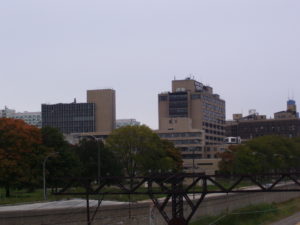
The Lost — and the Saved
As renowned as Chicago is for its architecture, there have been several significant (and painful) losses during its history. The Home Insurance Building, designed by William LeBaron Jenney and arguably the first true skyscraper (or at least one of the first true skyscrapers, depending on whom you ask) was razed in 1932 to make room for the 140 S. LaSalle building, admittedly another architectural icon. Photographer Richard Nickel lost his life attempting to chronicle the demolition of Louis Sullivan’s Stock Exchange Building. More recently, the demolition of the Bertrand Goldberg-designed Prentice Hospital sparked fierce controversy.

Losses have occurred outside the Loop as well. One of the most controversial instances was the demolition of nearly the entire Michael Reese Hospital campus in Bronzeville on Chicago’s near South Side as part of Chicago’s ill-fated bid for the 2016 Summer Olympic Games.
The campus was included on Preservation Chicago’s 7 Most Endangered List of 2009, as well as on Landmark Illinois’ 2009 Most Endangered Buildings list. Eight mid-century Modernist buildings located on the site were designed with the influence of Walter Gropius, former director of the Bauhaus and planning consultant for the hospital campus development during the period after World War II. Ultimately only the Gropius-influenced Singer Pavilion (completed in 1948) remained standing on the immense 48-acre parcel.

In June 2017, Mayor Rahm Emanuel announced that a development team led by Farpoint Development, Draper & Kramer, Chicago Neighborhood Initiatives, McLaurin Development Partners and Bronzeville Community Development Partnership, with Skidmore, Owings & Merrill serving as consultant architect had been chosen to build out the long-vacant parcel. The collaborative is collectively known as GRIT — an acronym for Global Research, Innovation & Tourism. However, according to Paula Robinson, who is in charge of the nonprofit Bronzeville Community Development Partnership, GRIT also stands for “Get Ready; It’s Time”. The former Michael Reese site, including plans for a restored and repurposed Singer Pavilion, has been proposed as a location for the much-sought-after Amazon second headquarters.
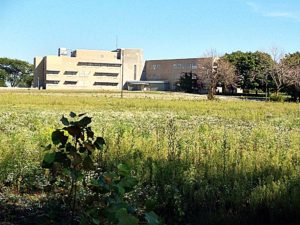
In contrast to the controversy surrounding the demolition of buildings on the Michael Reese Hospital campus, the South Side Masonic Temple, designed by architect Clarence Hatzfield and constructed on the 6400 block of S. Green in Englewood in 1921, was demolished in early 2018 with practically no fanfare. Included in Preservation Chicago’s 2004 7 Most Endangered list, and again in both 2007 and 2015, the structure was acquired in 1997 by Prologue schools. The network of alternative educational facilities hoped to rehabilitate the building for one of its campuses. The building also stood nearly adjacent to Kennedy-King College, one of the colleges within the City Colleges of Chicago community college system, and hopes were raised that it would be included in its campus. However, both sets of plans ultimately fell through. In the end, the huge structure stood empty and neglected for so long that restoration ceased to be a viable option.
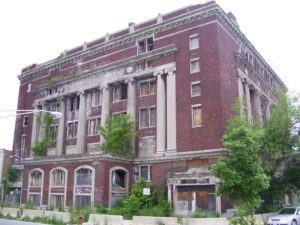
However, there are also positive stories associated with architecture beyond Chicago’s Loop. The Hilliard Towers Apartments, formerly known as the Raymond Hilliard Homes, another Goldberg design completed in 1966 was originally constructed as public housing. Goldberg designed the complex, located in Chinatown; nearly adjacent to McCormick Place to counter what he viewed as the prevailing notion that public housing should somehow punish and shame its residents for being poor.
Over time, the complex fell into disrepair. But after being listed on the National Register of Historic Places in 1999, Hilliard became eligible for federal tax credits and other public financing. The Chicago Housing Authority, along with private developers, spent $1.6 billion to restore the complex into a mixed-income development for seniors and families, finishing the restoration in 2006.
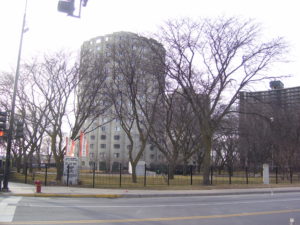
The Rosenwald Courts, located on the 4600 block of S. Michigan represent another successful restoration of an architectural icon. Developed by Julius Rosenwald to provide housing for middle-class black households during a period of strict housing segregation in Chicago, the massive structure was completed in 1930. Originally named the Michigan Boulevard Garden Apartments, the development originally included 420+ apartments with three to five rooms each. At various times, prominent African Americans including Nat King Cole, Duke Ellington, Lorraine Hansberry, Joe Louis, Quincy Jones, Ralph Metcalfe, Jesse Owens, community activist Robert Taylor and surgeon Dr. Daniel Hale Williams resided in the Rosenwald building

However, in the 1950s and 1960s the area began to decline, and the Rosenwald building declined along with it. Contaminated with lead paint and infested with rodents, the building ceased to serve as housing in 2000, despite being included on the National Register of Historic Places in 1981. In 2003, the National Trust placed the Rosenwald building on its “Eleven Most Endangered Historic Places” list.
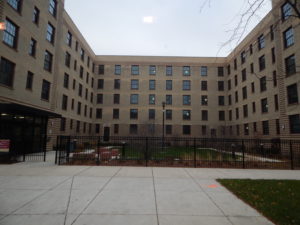
However, like the Hilliard Tower Apartments, the Rosenwald Courts story has a happy ending. After remaining vacant for nearly 15 years, capital funding was secured to restore the Rosenwald building on the last day of 2014. Construction began in 2015, and the newly restored building, with 239 residential units, along with office and retail spaces opened its doors during the second half of 2016. The building is now fully occupied with a substantial waiting list.
Next in the series: A consideration of “small-a” architecture in Chicago beyond the Loop: Part 2 — Culture.
